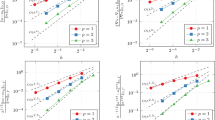Abstract
Mortar methods with dual Lagrange multiplier bases provide a flexible, efficient and optimal way to couple different discretization schemes or nonmatching triangulations. Here, we generalize the concept of dual Lagrange multiplier bases by relaxing the condition that the trace space of the approximation space at the slave side with zero boundary condition on the interface and the Lagrange multiplier space have the same dimension. We provide a new theoretical framework within this relaxed setting, which opens a new and simpler way to construct dual Lagrange multiplier bases for higher order finite element spaces. As examples, we consider quadratic and cubic tetrahedral elements and quadratic serendipity hexahedral elements. Numerical results illustrate the performance of our approach.
Similar content being viewed by others

References
Bastian, P., Birken, K., Johannsen, K., Lang, S., Neuß, N., Rentz–Reichert, H., Wieners, C.: UG – a flexible software toolbox for solving partial differential equations. Computing and Visualization in Science 1, 27–40 (1997)
Ben Belgacem, F.: The mortar finite element method with Lagrange multipliers. Numer. Math. 84, 173–197 (1999)
Ben Belgacem, F., Maday, Y.: The mortar element method for three dimensional finite elements. M2AN 31, 289–302 (1997)
Ben Belgacem, F., Seshaiyer, P., Suri, M.: Optimal convergence rates of hp mortar finite element methods for second-order elliptic problems. M2AN Math. Model. Numer. Anal. 34(3), 591–608 (2000)
Bernardi, C., Debit, N., Maday, Y.: Coupling finite element and spectral methods: First results. Math. Comp. 54, 21–39 (1990)
Bernardi, C., Maday, Y., Patera, A.T.: Domain decomposition by the mortar element method. In: H. Kaper et al., (ed) Asymptotic and numerical methods for partial differential equations with critical parameters, Reidel, Dordrecht, 1993 pp 269–286
Bernardi, C., Maday, Y., Patera, A.T.: A new nonconforming approach to domain decomposition: the mortar element method. In H. Brezzi et al., (ed) Nonlinear partial differential equations and their applications, Paris, 1994 pp 13–51
Braess, D., Dahmen, W.: Stability estimates of the mortar finite element method for 3–dimensional problems. East–West J. Numer. Math. 6, 249–264 (1998)
Braess, D., Dahmen, W., Wieners, C.: A multigrid algorithm for the mortar finite element method. SIAM J. Numer. Anal. 37, 48–69 (1999)
Brezzi, F., Fortin, M.: Mixed and hybrid finite element methods. Springer–Verlag, New York, 1991
Clément, P.: Approximation by finite element functions using local regularization. RAIRO Anal. Numér. 9, 77–84 (1975)
Dahmen, W., Faermann, B., Graham, I.G., Hackbusch, W., Sauter, S.A.: Inverse inequalities on non-quasiuniform meshes and application to the mortar element method. Math. Comp. 73, 1107–1138 (2004)
DeVore, R.: Nonlinear approximation. Acta Numer. 7, 51–150 (1998)
Gopalakrishnan, J., Pasciak, J.: Multigrid for the mortar finite element method. SIAM J. Numer. Anal. 37, 1029–1052 (2000)
Grisvard, P.: Elliptic problems in nonsmooth domains, volume 24 of Monographs and Studies in Mathematics. Pitman (Advanced Publishing Program), Boston, MA, 1985
Huang, J., Zou, J.: A mortar element method for elliptic problems with discontinuous coefficients. IMA J. Numer. Anal. 22(4), 549–576 (2002)
Kim, C., Lazarov, R.D., Pasciak, J.E., Vassilevski, P.S.: Multiplier spaces for the mortar finite element method in three dimensions. SIAM J. Numer. Anal. 39, 519–538 (2001)
Lamichhane, B.P., Wohlmuth, B.I.: Higher order dual Lagrange multiplier spaces for mortar finite element discretizations. CALCOLO 39, 219–237 (2002)
Lamichhane, B.P., Wohlmuth, B.I.: A quasi-dual Lagrange multiplier space for serendipity mortar finite elements in 3D. M2AN 38, 73–92 (2004)
Lions, J.-L., Magenes, E.: Non-homogeneous boundary value problems and applications. Vol. I Springer-Verlag, New York, 1972 Translated from the French by P. Kenneth, Die Grundlehren der mathematischen Wissenschaften, Band 181
Oswald, P.: Multilevel finite element approximation: Theory and applications. B.G. Teubner, Stuttgart, 1994
Oswald, P., Wohlmuth, B.I.: On polynomial reproduction of dual FE bases. In: N. Debit, M. Garbey, R. Hoppe, J. Pèriaux, D. Keyes, and Y. Kuznetsov (eds.) Thirteenth International Conference on Domain Decomposition Methods 2001 pp 85–96
Scott, L.R., Zhang, S.: Finite element interpolation of nonsmooth functions satisfying boundary conditions. Math. Comp. 54(190), 483–493 (1990)
Seshaiyer, P., Suri, M.: Uniform hp convergence results for the mortar finite element method. Math. Comp. 69(230), 521–546 (2000)
Triebel, H.: Interpolation theory, function spaces, differential operators, Volume 18 of North-Holland Mathematical Library. North-Holland Publishing Co., Amsterdam, 1978
Wieners, C., Wohlmuth, B.I.: Duality estimates and multigrid analysis for saddle point problems arising from mortar discretizations. SISC 24, 2163–2184 (2003)
Wohlmuth, B.I.: A mortar finite element method using dual spaces for the Lagrange multiplier. SIAM J. Numer. Anal. 38, 989–1012 (2000)
Wohlmuth, B.I.: Discretization Methods and Iterative Solvers Based on Domain Decomposition, Volume 17 of LNCS. Springer Heidelberg, 2001
Wohlmuth, B.I.: A comparison of dual Lagrange multiplier spaces for mortar finite element discretizations. M2AN 36, 995–1012 (2002)
Wohlmuth, B.I., Krause, R.H.: Multigrid methods based on the unconstrained product space arising from mortar finite element discretizations. SIAM J. Numer. Anal. 39, 192–213 (2001)
Author information
Authors and Affiliations
Corresponding author
Additional information
This work was supported in part by the Deutsche Forschungsgemeinschaft, SFB 404, C12, the Netherlands Organization for Scientific Research and by the European Community's Human Potential Programme under contract HPRN-CT-2002-00286.
Rights and permissions
About this article
Cite this article
Lamichhane, B., Stevenson, R. & Wohlmuth, B. Higher Order Mortar Finite Element Methods in 3D with Dual Lagrange Multiplier Bases. Numer. Math. 102, 93–121 (2005). https://doi.org/10.1007/s00211-005-0636-z
Received:
Revised:
Published:
Issue Date:
DOI: https://doi.org/10.1007/s00211-005-0636-z



